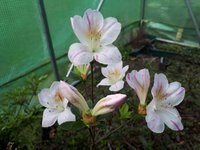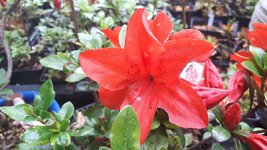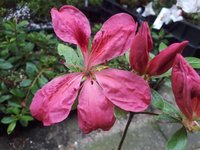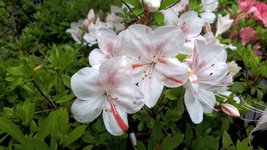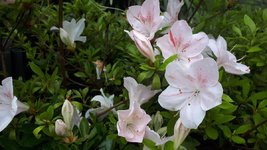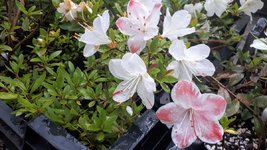You are using an out of date browser. It may not display this or other websites correctly.
You should upgrade or use an alternative browser.
You should upgrade or use an alternative browser.
Glaucus Satsuki Azalea farm
- Thread starter Glaucus
- Start date
Glaucus
Omono
Another nice one:

'Milesovka' x 'Hanatsuzuri' crossbreed. So reverse from the others. Also shows it usually doesn't really matter which plant is the seed or pollen parent.
The flowers on this one are large. The entire flower is pale purple, not white. And many small purple spots. And of course the very distinct blotch.
I have some nice dark coloured satsuki x kurume hybrids, but their monocolours often don't capture well. And the solid colours don't make for a good picture.
The true satsuki are now also starting, but most have just a few flowers and they were spoiled with sunright or watering, because the flowers are closer to the ground.
They will give a good show maybe for nice pictures next year.

'Milesovka' x 'Hanatsuzuri' crossbreed. So reverse from the others. Also shows it usually doesn't really matter which plant is the seed or pollen parent.
The flowers on this one are large. The entire flower is pale purple, not white. And many small purple spots. And of course the very distinct blotch.
I have some nice dark coloured satsuki x kurume hybrids, but their monocolours often don't capture well. And the solid colours don't make for a good picture.
The true satsuki are now also starting, but most have just a few flowers and they were spoiled with sunright or watering, because the flowers are closer to the ground.
They will give a good show maybe for nice pictures next year.
Glaucus
Omono
Some above average 100% satsuki flowers:


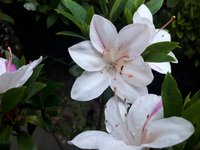
All thee different Hekisui x Hanatsuzuri seedlings. Some distinct blotches, coming from Hanatsuzuri. But not like those combined with Milesovka.
Now that I picked these out, I can shelter them next year. And then in 2025 as larger plants they will make for a better larger plant full flower display. Now I just picked out a good flower without any blemishes.
They all show good shibori/variegation.



All thee different Hekisui x Hanatsuzuri seedlings. Some distinct blotches, coming from Hanatsuzuri. But not like those combined with Milesovka.
Now that I picked these out, I can shelter them next year. And then in 2025 as larger plants they will make for a better larger plant full flower display. Now I just picked out a good flower without any blemishes.
They all show good shibori/variegation.
Glaucus
Omono
Flowering near peak on most of the seedlings in the growing field:

I have three rows of large flowering purple-leaning part satsuki crossbreeds. These grow well, but are not my taste. Maybe a really cold winter can show me which ones are truly hardy. But I kinda need to get rid of these next year and clean up this space:

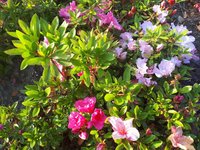
Some are pale coloured, white centers, or coral red. I tried to get rid of the lame pink and paler violet ones. No exciting variagation on these at all. Just healthy plants with large flowers.
Some quite a nice dark colour

These would be very hard to turn into bonsai. Almost all have several branches/stems coming out of the roots.
The Suisen (diploid) x WischiWaschi crosses grow less well. Plants are much smaller and some are not at full health.

Also much more variation in leaf shape, I would say. Many are white, plenty are variagated. I picked out the ones with a stronger blotch (these are not pictures), but nothing are anywhere close to the 'Milesovka' x 'Hanatsuzuri' crossbreeds.
I feel many are better than Wishi Waschi itself. I got two plants from Hachmann and they don't do so well in my garden. Pale leaves, slow growth.



I picked out a few nices ones that are not pictures. I may end up composting/giving away almost all of these next year and rotate in new crosses.
Next, the Kangiten x Čertoryje row. These are 1 year younger. Only planted them here last autumn.
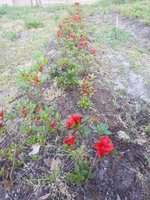
All are red. All are upright and more bald. Most of them shred lot of leaves during winter.
Too early to pick any favourites:

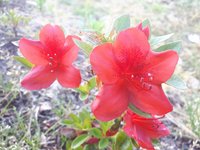

They are all in full sun, so they do seem to bleach. Maybe next year I'll find out one that doesn't bleach. These are still early on, most just opening. Plants have plenty of space to grow bigger without running into each other.
These can stay here for a couple of more years.
The 'Hanatsuzuri' 'x ''Milesovka' rows. These have many nice ones, most I picked out.

The 'bad'ones are still pretty good. But since I have almost 10 quite to really good ones, I could reduce this row from 2 to 1 next year.


These could conceivably be pruned into a bonsai shape. But they have never been wired. They lean towards naturally being a single trunk, but more bushy than a obtusum/kurume type.
Rainstorms incoming pretty soon. Good for growth, but not so good for the flowers.

I have three rows of large flowering purple-leaning part satsuki crossbreeds. These grow well, but are not my taste. Maybe a really cold winter can show me which ones are truly hardy. But I kinda need to get rid of these next year and clean up this space:


Some are pale coloured, white centers, or coral red. I tried to get rid of the lame pink and paler violet ones. No exciting variagation on these at all. Just healthy plants with large flowers.
Some quite a nice dark colour

These would be very hard to turn into bonsai. Almost all have several branches/stems coming out of the roots.
The Suisen (diploid) x WischiWaschi crosses grow less well. Plants are much smaller and some are not at full health.

Also much more variation in leaf shape, I would say. Many are white, plenty are variagated. I picked out the ones with a stronger blotch (these are not pictures), but nothing are anywhere close to the 'Milesovka' x 'Hanatsuzuri' crossbreeds.
I feel many are better than Wishi Waschi itself. I got two plants from Hachmann and they don't do so well in my garden. Pale leaves, slow growth.



I picked out a few nices ones that are not pictures. I may end up composting/giving away almost all of these next year and rotate in new crosses.
Next, the Kangiten x Čertoryje row. These are 1 year younger. Only planted them here last autumn.

All are red. All are upright and more bald. Most of them shred lot of leaves during winter.
Too early to pick any favourites:



They are all in full sun, so they do seem to bleach. Maybe next year I'll find out one that doesn't bleach. These are still early on, most just opening. Plants have plenty of space to grow bigger without running into each other.
These can stay here for a couple of more years.
The 'Hanatsuzuri' 'x ''Milesovka' rows. These have many nice ones, most I picked out.

The 'bad'ones are still pretty good. But since I have almost 10 quite to really good ones, I could reduce this row from 2 to 1 next year.


These could conceivably be pruned into a bonsai shape. But they have never been wired. They lean towards naturally being a single trunk, but more bushy than a obtusum/kurume type.
Rainstorms incoming pretty soon. Good for growth, but not so good for the flowers.
Glaucus
Omono
Deep Sea Diver
Imperial Masterpiece
Awesome!
The first pictured azalea looks an awful lot like Polo from a 2D view. It’s night here otherwise I’d toss in an image.
Ceers
DSD sends
The first pictured azalea looks an awful lot like Polo from a 2D view. It’s night here otherwise I’d toss in an image.
Ceers
DSD sends
Deep Sea Diver
Imperial Masterpiece
Glaucus
Omono
Yeah, the flower looks similar. I believe this is a Marashino(Maruschka sport) x Hekisui seedling. That's the only combination with a high rate of white centers that I obtained.
The flower reminded me more of Beniko, though. For white centers, maybe it is ideal to have half the surface area (or maybe halfway the diameter) a clear white, or near white, the other 50% a bright colour. And the barrier between them very distinct. And the pattern of white being quite symmetrical. You can see how in your polo it fades to a darked reddish pink. The flower I pictured wasn't fully opened yet, and it had just a few flower buds. Next year maybe I can find one that matches most of my description.
There's many white center cultivar already out there, including kurume x satsuki hybrids, like Izumi no Mai, which is quite available from the ordinary garden nursery industry here in Europe.
The white center with a strong blotch that offsets the effect, like 'Marian Lee' is also a pretty good combination. I believe I have one seedling similar to that, but no picture.
Maybe I should try a cross with a blotch effect seedling with a very large white center kurume-satsuki hybrid next year. Maybe that can give a blotch effect flower, but with a thin margin of colour on the outer petal.
The Japanese have the infamous bullseye/yanome pattern. Where you have a white center plus a fukurin pattern, creating a ring of colour. It is quite a rare pattern, but displayed on the cover of Callaham's book.
Maybe a reverse bulls eye is also possible. No reason why you couldn't have a jewel border/fukurin flower, but with a very thin petal margin colour on the outer edge, a strong blotch, but also a white center.
Like a double janome/bull's eye.
The flower reminded me more of Beniko, though. For white centers, maybe it is ideal to have half the surface area (or maybe halfway the diameter) a clear white, or near white, the other 50% a bright colour. And the barrier between them very distinct. And the pattern of white being quite symmetrical. You can see how in your polo it fades to a darked reddish pink. The flower I pictured wasn't fully opened yet, and it had just a few flower buds. Next year maybe I can find one that matches most of my description.
There's many white center cultivar already out there, including kurume x satsuki hybrids, like Izumi no Mai, which is quite available from the ordinary garden nursery industry here in Europe.
The white center with a strong blotch that offsets the effect, like 'Marian Lee' is also a pretty good combination. I believe I have one seedling similar to that, but no picture.
Maybe I should try a cross with a blotch effect seedling with a very large white center kurume-satsuki hybrid next year. Maybe that can give a blotch effect flower, but with a thin margin of colour on the outer petal.
The Japanese have the infamous bullseye/yanome pattern. Where you have a white center plus a fukurin pattern, creating a ring of colour. It is quite a rare pattern, but displayed on the cover of Callaham's book.
Maybe a reverse bulls eye is also possible. No reason why you couldn't have a jewel border/fukurin flower, but with a very thin petal margin colour on the outer edge, a strong blotch, but also a white center.
Like a double janome/bull's eye.
Last edited:
Glaucus
Omono
Pitoon
Imperial Masterpiece
Those first four pics look superb!View attachment 548955
View attachment 548956
View attachment 548958
View attachment 548959
Many satsuki are now done flowering. Weather is wet, rain, cloudy, tons of snails, more rain. Impossible to fight petal blight. But these look quite good.
View attachment 548957
Glaucus
Omono
I did make the colours pop a bit more, like usual, using the Google Photos sliders. The first one is a seedling of my own We1 (Wintergreen x Hekisui). Those seedlings all turn out pretty good.
I believe 2 and 3 are different plants, but very similar I see now. 4 has the larger variegation/shibori. It seems that both Hanatsuzuri and Kangiten, or at least the flowers from which I took pollen, result in fine/small variegation. Picture 4 has different parentage.
I believe 2 and 3 are different plants, but very similar I see now. 4 has the larger variegation/shibori. It seems that both Hanatsuzuri and Kangiten, or at least the flowers from which I took pollen, result in fine/small variegation. Picture 4 has different parentage.
Glaucus
Omono
Glaucus
Omono
Glaucus
Omono
Some observations after most of the 2024 growing season has passed.
When I have satsuki-gene seedlings in a 9cm pot for too long and I don't repot them, their colour turns pale green and the growth slows down. They are likely pot bound and the peat has degraded, lost most of it's nutrients, and the pH has gone towards 7 because of the tap water.
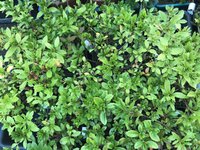
Ideally, these were all repotted to larger pots, 11cm square or 15cm, round. Likely, these didn't flower and I wasn't able to judge to either throw them away, or select them out and uppot them.
When the same is true, but they have more obtusum/kurume genes, very often their leaves turn red because of drought stress:

When I had a pot bound seedling and I did repot them around late May into 15cm round pots, they now look like this:

A lot of growth and all very dark green.
Similarly, younger seedlings that were too young to even flower this spring, and that were moved to 9cm square pots, they look like this:
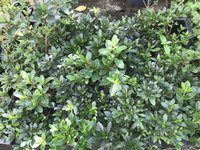
When I don't water these in time, they will go limp. If I wait even longer after they go limp, they will get damaged. And that could even make them susceptible to aphids. Which they normally don't suffer from.
This elongated growth is very different from what I had in a tray of seedlings, no picture, where the seedlings grew to have very short and durable shoots. The seedling tray would dry out often, take full sun, get hot. But those seedlings had adapted to that environment. These seedlings were older, didn't grow optimally, but also suffered no chlorosis or disease. I could transplant them without them suffering any transplantation shock. And I am pretty sure that after this transplant, they went into the type of elongated growth as pictures here. Sadly, I do not have pictures of the same seedlings before and after repot, picturing the same growth mode. But it is very distinct difference.
Sometimes, there is the rare seedling that does get chlorosis, even though all their sister siblings in the same environment do not. These are freshly repotted, but there is just one that is not healthy:

This tray is in a spot with a bit too much shade, I believe. Which may mean these seedlings stay a bit too wet.
Similarly, I have some cuttings that are in a spot too shaded. And when they develop liverworts on the surface, that means they are too wet with too much shade.S
So for peat/perlite mixes, this can be used as an indicator. If you see liverworts, it means your azaleas are likely too shaded and need more sun. And the sun can dry out the top of the soil. Which improves root growth & health because the roots actually like drier soils.
So it seems that taking a seedling that is almost pot bound in early spring, and then transplanting it into a new pot with 45/45/10 perlite/peat&ericaceous potting mix/5 pine bark, and adding 18 month osmocote is ideal for me.
I think I favour using slightly more perlite now. In the past, maybe it was 33/33/33 perlite/peat/potting mix.
This mix has been so good for me that I moved all my Japanese imports, that were in kanuma, into this mixture. And their health improved by a lot. I got these plants imported from Japan. And many were in rather fresh kanuma, so I kept them in it.
However, some declined in health, got very pale leaves, or even chlorosis. Some even looked like they might be dying. Which was kind of embarrassing for me, to be honest.
But, now they are in my peat/perlite potting mix, their health improved a lot. I did not bare root them. I removed a lot of the kanuma, added some kanuma to my usual mix, and repotted them.
Some now look like this:


That 'Akari' in fact was looking like it was gonna die. So I really didn't want to take a picture. But somehow, it completely transformed in health, with many dark green shoots now growing.
I believe those that looked worst, I put in peat-perlite the earliest. And now they actually look best. The transformation is so crazy, I am actually thinking of trying to repeat it as an experiment to document it properly.
Note, the summer has been reasonably wet, not too many hot days over 30C. And I did give them liquid fertilizer which I added to RO water at leat twice, keeping the EC value around 0.6 mS/cm. Which is also my tap water value.
I am really starting to think that having azaleas in 100% kanuma, during hot dry summers, where I need to water them with tap water daily is no good.
I still do have some azaleas in 100% kanuma that are doing well. But those Japanese imports started growing way better now that they are in peat/perlite.
At the same time. the way I grow azaleas now means they need to grow into rapid vegetative growth. I need to give them fresh peat every 1.5 years to expand into. So uppotting them with 2 to 4 cm more diameter of new peat/perlite after raking open their root ball.
It is easier to bare root azaleas that are in kanuma. And to better prune their roots to set up for nebari, though. But horticulture-wise, I don't see why I would use kanuma. My working theory is that the peat was way larger buffering capacity to keep the pH lower for longer, considering the bicarbonate I introduce through the tap water.
That is not a bonsai way of growing azaleas.
When I have satsuki-gene seedlings in a 9cm pot for too long and I don't repot them, their colour turns pale green and the growth slows down. They are likely pot bound and the peat has degraded, lost most of it's nutrients, and the pH has gone towards 7 because of the tap water.

Ideally, these were all repotted to larger pots, 11cm square or 15cm, round. Likely, these didn't flower and I wasn't able to judge to either throw them away, or select them out and uppot them.
When the same is true, but they have more obtusum/kurume genes, very often their leaves turn red because of drought stress:

When I had a pot bound seedling and I did repot them around late May into 15cm round pots, they now look like this:

A lot of growth and all very dark green.
Similarly, younger seedlings that were too young to even flower this spring, and that were moved to 9cm square pots, they look like this:

When I don't water these in time, they will go limp. If I wait even longer after they go limp, they will get damaged. And that could even make them susceptible to aphids. Which they normally don't suffer from.
This elongated growth is very different from what I had in a tray of seedlings, no picture, where the seedlings grew to have very short and durable shoots. The seedling tray would dry out often, take full sun, get hot. But those seedlings had adapted to that environment. These seedlings were older, didn't grow optimally, but also suffered no chlorosis or disease. I could transplant them without them suffering any transplantation shock. And I am pretty sure that after this transplant, they went into the type of elongated growth as pictures here. Sadly, I do not have pictures of the same seedlings before and after repot, picturing the same growth mode. But it is very distinct difference.
Sometimes, there is the rare seedling that does get chlorosis, even though all their sister siblings in the same environment do not. These are freshly repotted, but there is just one that is not healthy:

This tray is in a spot with a bit too much shade, I believe. Which may mean these seedlings stay a bit too wet.
Similarly, I have some cuttings that are in a spot too shaded. And when they develop liverworts on the surface, that means they are too wet with too much shade.S
So for peat/perlite mixes, this can be used as an indicator. If you see liverworts, it means your azaleas are likely too shaded and need more sun. And the sun can dry out the top of the soil. Which improves root growth & health because the roots actually like drier soils.
So it seems that taking a seedling that is almost pot bound in early spring, and then transplanting it into a new pot with 45/45/10 perlite/peat&ericaceous potting mix/5 pine bark, and adding 18 month osmocote is ideal for me.
I think I favour using slightly more perlite now. In the past, maybe it was 33/33/33 perlite/peat/potting mix.
This mix has been so good for me that I moved all my Japanese imports, that were in kanuma, into this mixture. And their health improved by a lot. I got these plants imported from Japan. And many were in rather fresh kanuma, so I kept them in it.
However, some declined in health, got very pale leaves, or even chlorosis. Some even looked like they might be dying. Which was kind of embarrassing for me, to be honest.
But, now they are in my peat/perlite potting mix, their health improved a lot. I did not bare root them. I removed a lot of the kanuma, added some kanuma to my usual mix, and repotted them.
Some now look like this:


That 'Akari' in fact was looking like it was gonna die. So I really didn't want to take a picture. But somehow, it completely transformed in health, with many dark green shoots now growing.
I believe those that looked worst, I put in peat-perlite the earliest. And now they actually look best. The transformation is so crazy, I am actually thinking of trying to repeat it as an experiment to document it properly.
Note, the summer has been reasonably wet, not too many hot days over 30C. And I did give them liquid fertilizer which I added to RO water at leat twice, keeping the EC value around 0.6 mS/cm. Which is also my tap water value.
I am really starting to think that having azaleas in 100% kanuma, during hot dry summers, where I need to water them with tap water daily is no good.
I still do have some azaleas in 100% kanuma that are doing well. But those Japanese imports started growing way better now that they are in peat/perlite.
At the same time. the way I grow azaleas now means they need to grow into rapid vegetative growth. I need to give them fresh peat every 1.5 years to expand into. So uppotting them with 2 to 4 cm more diameter of new peat/perlite after raking open their root ball.
It is easier to bare root azaleas that are in kanuma. And to better prune their roots to set up for nebari, though. But horticulture-wise, I don't see why I would use kanuma. My working theory is that the peat was way larger buffering capacity to keep the pH lower for longer, considering the bicarbonate I introduce through the tap water.
That is not a bonsai way of growing azaleas.
namnhi
Masterpiece
Very nice. Liked what you are doing.
Deep Sea Diver
Imperial Masterpiece
Sure looks like you have been learning an awful lot! Your work is remarkable and results keep improving. Well done Mark!But, now they are in my peat/perlite potting mix, their health improved a lot. I did not bare root them. I removed a lot of the kanuma, added some kanuma to my usual mix, and repotted them.
Some now look like
It is easier to bare root azaleas that are in kanuma. And to better prune their roots to set up for nebari, though. But horticulture-wise, I don't see why I would use kanuma. My working theory is that the peat was way larger buffering capacity to keep the pH lower for longer, considering the bicarbonate I introduce through the tap water.
That is not a bonsai way of growing azaleas.
We all appreciate you sharing the bad results with the good results. All of us run into perplexing situations when growing only a couple azaleas where plants seem to ail for no reason. My belief it’s because most hobbyists only grow a small number of azalea bonsai. Seeing images of large scale findings really helps.
Horticulturally totally agree about growing in peat blends. It seems an expensive proposition, materially and dollars wise, to grow in kanuma. One cannot expect similar results as in a peat variation media.
From a bonsai perspective transitioning a young plant into kanuma too early sets one back. However 3-12 months after nebari is properly set up upon transition into a good kanuma blend with moss covering the tree growth accelerates… In fact, some of the robust garden azalea cultivars we experiment with and larger Satsuki cultivar’s growth accelerates so much they require extra (beyond the usual 2-3) cut backs to keep in check.
But once transitioned into a kanuma blend, it’s really hard to compare growth in kanuma to peat blend. But guarantee the peat is superior for a few years. Then the disadvantages kick in.
Once a tree is set up into bonsai media the azaleas are constantly being pruned back and reshaped. It’s a disadvantage after a certain point to have a bonsai azalea, like those in peat, constantly pushing very coarse, longish growth
As you know we’ve been experimenting with moss and succulents etc on many of our azalea plants.
With peat/perlite 60/40 in 2 1/4” pots, the trees do well at the three year mark given a surface covering. Haven’t tried it longer. When the roots are teased and up potted into a 4” nursery potting container in peat/perlite/small bark 33/33/33 the plants all seem static with normal growth for about 3 months, then they explode with growth.
In kanuma perlite biochar with moss etc 85/10/5, the plants all do very well throughout the year, but best in only morning or only mid to late afternoon noon sun. But can withstand up to 70% sun… but that requires more water and morning misting.
However we can say with confidence azaleas after five years and hundreds of plants, azaleas in kanuma without a deep moss covering grow less, are much less resilient, grow less and are much more susceptible to lace bug, sun and drought damage.
The moss we use is Yamagoke (mountain moss) as it’s much easier to start than Sphagnum blends so haven’t compared these but would believe once started this covering offers similar benefits.
(Our pH varies from 7.0 (winter) to 8.5 (summer) but our carbonates are low.)
Best
DSD sends
Glaucus
Omono
My tapwater bicarbonate is 231 mg/L and the German hardness is 7.3D or 1.30 mmol/L. Yours could be significantly lower, right? You have rain eroded rocks in the Pacific Northwest, which means lower hardness.
Interesting that you see a big benefit for moss on kanuma. I still remove the collar of moss on a repot. Often in the top 1cm of soil, there are only moss roots and I rip that part off when repotting. The ones that are growing really well right now are in fresh soil with zero moss. Ripping off the moss layer is a good way to open up the top of the root ball, get some old soil out and new soil in.
Yes, older more mature plants, with more wood parts, that grow slower, are a different subject. Especially those are being pruned and in a bonsai pot. Does Dan Robinson have any azaleas that were not repotted for a very long time? I can definitely see an advantage to having older satsuki bonsai in shallow pots with kanuma. With peat, they would need a repot way too often. But, I have not tried either. I wonder if the type of growth one gets is indeed determined by the substrate, all else being equal. You'd think that if the substrate is good, and the plant wants to grow a lot, it will. The imported plants I got, that were in kanuma, showed that elongated vegetative growth. Just once I got them, that stopped. Could be hard tap water, too little rain, and too little fertilizer. But I added biogold chunks on the kanuma for about a year and I didn't see any rapid change. But when I put them in peat, they improved very fast. I can't rule out that the improvement in health didn't come from the kanuma plus biogold, though.
Also, for too much wetness/rain in winter, I don't think it matters if the roots stay too wet when the plant is dormant. Because then it isn't growing and it doesn't need to take up nutrients.
Nature doesn't have any gnomes or kappa that come around and replace the old degraded organic matter or peat around the azalea roots, replacing it with fresh stuff, to keep plants growing optimally with long vegetative growth and dark leaves. So surely the genetics give the plant different growth modes depending on how ideal, or not ideal, the conditions are. Suboptimal growth and natural miniaturization that comes with it is of course the key element of bonsai. But you want that suboptimal growth mode without the bad growth like chlorosis. Of course I don't really prune. Those pot bound red kurume-types might have been a lot healthier if they had been leaf-pruned. Leading them to suffer less chronic drought stress. And they may have been more green.
Interesting that you see a big benefit for moss on kanuma. I still remove the collar of moss on a repot. Often in the top 1cm of soil, there are only moss roots and I rip that part off when repotting. The ones that are growing really well right now are in fresh soil with zero moss. Ripping off the moss layer is a good way to open up the top of the root ball, get some old soil out and new soil in.
Yes, older more mature plants, with more wood parts, that grow slower, are a different subject. Especially those are being pruned and in a bonsai pot. Does Dan Robinson have any azaleas that were not repotted for a very long time? I can definitely see an advantage to having older satsuki bonsai in shallow pots with kanuma. With peat, they would need a repot way too often. But, I have not tried either. I wonder if the type of growth one gets is indeed determined by the substrate, all else being equal. You'd think that if the substrate is good, and the plant wants to grow a lot, it will. The imported plants I got, that were in kanuma, showed that elongated vegetative growth. Just once I got them, that stopped. Could be hard tap water, too little rain, and too little fertilizer. But I added biogold chunks on the kanuma for about a year and I didn't see any rapid change. But when I put them in peat, they improved very fast. I can't rule out that the improvement in health didn't come from the kanuma plus biogold, though.
Also, for too much wetness/rain in winter, I don't think it matters if the roots stay too wet when the plant is dormant. Because then it isn't growing and it doesn't need to take up nutrients.
Nature doesn't have any gnomes or kappa that come around and replace the old degraded organic matter or peat around the azalea roots, replacing it with fresh stuff, to keep plants growing optimally with long vegetative growth and dark leaves. So surely the genetics give the plant different growth modes depending on how ideal, or not ideal, the conditions are. Suboptimal growth and natural miniaturization that comes with it is of course the key element of bonsai. But you want that suboptimal growth mode without the bad growth like chlorosis. Of course I don't really prune. Those pot bound red kurume-types might have been a lot healthier if they had been leaf-pruned. Leading them to suffer less chronic drought stress. And they may have been more green.
Last edited:
Deep Sea Diver
Imperial Masterpiece
Our bicarbonate is reported in fall last year 1.48 grains/gal. pH 8.2My tapwater bicarbonate is 231 mg/L and the German hardness is 7.3D or 1.30 mmol/L. Yours could be significantly lower, right? You have rain eroded rocks in the Pacific Northwest, which means lower hardness.
Likely highest figure2 as taken after our summer drought period.
Thinking putting new soil on the bottom and sides and leaving the moss on top would be better for the plant… also for future nebari as it won’t create a new nebari. So that is what I do.Interesting that you see a big benefit for moss on kanuma. I still remove the collar of moss on a repot. Often in the top 1cm of soil, there are only moss roots and I rip that part off when repotting. The ones that are growing really well right now are in fresh soil with zero moss. Ripping off the moss layer is a good way to open up the top of the root ball, get some old soil out and new soil in.
In horticultural case, likely this might take more time?
Yes Dan has some that have been in the same pots for over 30 years. He started with deep pots and eventually all his azaleas have pushed upward.Yes, older more mature plants, with more wood parts, that grow slower, are a different subject. Especially those are being pruned and in a bonsai pot. Does Dan Robinson have any azaleas that were not repotted for a very long time?
Not experienced on this as have only worked azaleas in a couple media…. We know folks use many different media for azaleas, at least in the US (and all claim their media is superior to all others!?).I can definitely see an advantage to having older satsuki bonsai in shallow pots with kanuma. With peat, they would need a repot way too often. But, I have not tried either. I wonder if the type of growth one gets is indeed determined by the substrate, all else being equal.
Yet have taken many languishing azaleas completely out of amazing mixes of media though.
Could be the plants were no longer pampered as these were in Japan. Only experience we have with straight from Japan grown Satsuki are two plants, one large, one Shohin received this year. Of course both had been bare rooted shipped in moss and bare rooted again and packed in kanuma. One transitioned quickly, while the other was near dead upon arrival and took three months to return to fairly decent health. Still hasn’t become healthy and robust.You'd think that if the substrate is good, and the plant wants to grow a lot, it will. The imported plants I got, that were in kanuma, showed that elongated vegetative growth. Just once I got them, that stopped. Could be hard tap water, too little rain, and too little fertilizer.
But I added biogold chunks on the kanuma for about a year and I didn't see any rapid change. But when I put them in peat, they improved very fast. I can't rule out that the improvement in health didn't come from the kanuma plus biogold, though.
Once a plant has been in kanuma blend with minimal root disturbance of the roots (seedling media wash out) for awhile 6-8 weeks the growth accelerates over time. Even in a nursery pot. The growth approaches that of peat, but needs fertilizer to keep moving.
Cheers
DSD sends
Glaucus
Omono
I believe 231 mg/L equals 13.5 grains/gal. So my hardiness is almost 10x higher.
One should be able to get the same vigorous growth in kanuma. Maybe they need more fertilizer and less hard water than I have.
The roots being constrained and having run out of space must be what slows down growth and results ins shorter compact growth. Wrong pH. drought stress, too little fertilizer, too wet, all those things cannot give healthy but slow growth.
One should be able to get the same vigorous growth in kanuma. Maybe they need more fertilizer and less hard water than I have.
The roots being constrained and having run out of space must be what slows down growth and results ins shorter compact growth. Wrong pH. drought stress, too little fertilizer, too wet, all those things cannot give healthy but slow growth.
Glaucus
Omono
In 2012, I sowed my first evergreen azalea seeds. I used the east coast American azalea 'Alexander', which is a sibling of the famous satsuki 'Kinsai'. In 1962, Dr.Rokujo send seeds to Polly Hill, who operated a garden on Martha's Vineyard, MA. These seeds were the product of 'Kinsai' the famous narrow leaf, strap petal satsuki, crossbred with the Taiwanese azalea R.nakaharae, which grows at altitude in the many mountains of beautiful island formerly known as Formosa. This eventually gave rise to a cultivar named 'Alexander'.
Somehow this azalea was one of the few satsuki-like plants that made their way to the Netherlands. I am not sure how. There is a very large specimen in the Belmonte Arboretum in Wageningen. And Esveld is selling this plant. As are quite a few other nurseries, like Hachmann in Germany.
Polly Hill described 'Alexander' the following way:
'Alexander': the leaf is long and narrow with red hairs. Flowers are seven cm. across, vermilion red. Winter buds and pedicels are red. Winter foliage is a dark green-maroon. The plant spreads readily and cascades when permitted. It blooms in late June.
source: https://www.azaleas.org/wp-content/uploads/azalean/13/4/articles/North_Tisbury_Nakaharae_Azaleas.pdf
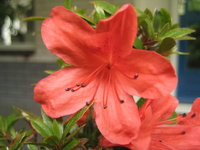
'Alexander'
I obtained a nice large 'Alexander' and used it as a seed parent. With pollen from cuttings of 'Hekisui', which is one of my favourite small-flowering satsuki. It is like a 'Kozan', but with smaller leaves and more interesting flower patterns.
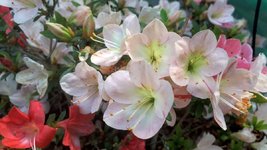
'Hekisui'
From these seeds the result were many Kozan-like reddish seedlings. More of an orangy red colour than a true deep red. But almost all were red. No pinks, no purples. And all had narrow leaves, like R.indicum. And some had the creeping habit of R.nakharae. None of them had white flowers with variegation though, though. Which was one thing I hoped to get alongside the R.indicum style foliage.
This gave me some seedlings that I codenamed Ae14 and Ae22:

Ae14

Ae22
Come 2021 and I decided to give some more breeding a chance. I obtained two 'Hanatsuzuri' plants directly imported from Japan. This has always been one of my favourite cultivars for flashy flowers.
'Hanatsuzuri' cultivar bonsai trees often win awards in the flower display/meika category.

source: http://naokien.sakura.ne.jp/tyuumoku/tyuumoku.html
In spring 2024, the Ae14 x Hanatsuzuri crossbreeding gave me some nice results:

The genes from R.nakaharae have been diluted in this generation to only 12.5% Their effect is to delay growth in early spring, so it stays dormant during late frosts.
This helps hardiness. However, it seems neither Alexander, Kozan, Hekisui, or Kinsai are hardy in Northern European zone 6, with -22C / -8F.
In parallel to this breeding, I took some European R.obtusum cultivars. These are based on R.kiusianum and R.kaempferi. Similar to kurume azaleas from Kurume city in Kyushu, Japan, Europe has their own breeding of these types of garden azaleas.
One famous cultivar is 'Maruschkha' released in 1975 by Hans Hachmann. An improved sport was obtained and named 'Maraschino'. This one is now even released in the US under the Kimono trademark by Monrovia nurseries, and others. This is a true zone 6 azalea, and a product of a lot of breeding, with famous European obtusum azaleas like 'Vuyk's Scarlet', 'Kermesina', 'Mother's Day' 'Hinodegiri' and 'Johanna' among the ancestors.
So this azalea I also crossbred with 'Hanatsuzuri'.
This gave many solid coloured seedlings with improved growth. Among them this very bright neon-coloured seedling:
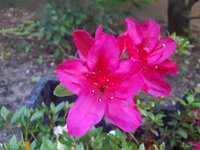
'Maraschino' x 'Hanatsuzuri'
So, the next logical step for me is to combine my 'Alexander' breeding with my 'Maraschino' breeding, to see if I can get a satsuki-like white-flowering plus variegated seedling that is hardy in zone 6 but also has some of the beneficial R.nakahrae traits and the R.indicum style foliage.
The first seeds of (Maraschino x Hanatsuzuri) x (Ae14 x Hanatsuzuri) were sown today.
Somehow this azalea was one of the few satsuki-like plants that made their way to the Netherlands. I am not sure how. There is a very large specimen in the Belmonte Arboretum in Wageningen. And Esveld is selling this plant. As are quite a few other nurseries, like Hachmann in Germany.
Polly Hill described 'Alexander' the following way:
'Alexander': the leaf is long and narrow with red hairs. Flowers are seven cm. across, vermilion red. Winter buds and pedicels are red. Winter foliage is a dark green-maroon. The plant spreads readily and cascades when permitted. It blooms in late June.
source: https://www.azaleas.org/wp-content/uploads/azalean/13/4/articles/North_Tisbury_Nakaharae_Azaleas.pdf

'Alexander'
I obtained a nice large 'Alexander' and used it as a seed parent. With pollen from cuttings of 'Hekisui', which is one of my favourite small-flowering satsuki. It is like a 'Kozan', but with smaller leaves and more interesting flower patterns.

'Hekisui'
From these seeds the result were many Kozan-like reddish seedlings. More of an orangy red colour than a true deep red. But almost all were red. No pinks, no purples. And all had narrow leaves, like R.indicum. And some had the creeping habit of R.nakharae. None of them had white flowers with variegation though, though. Which was one thing I hoped to get alongside the R.indicum style foliage.
This gave me some seedlings that I codenamed Ae14 and Ae22:

Ae14

Ae22
Come 2021 and I decided to give some more breeding a chance. I obtained two 'Hanatsuzuri' plants directly imported from Japan. This has always been one of my favourite cultivars for flashy flowers.
'Hanatsuzuri' cultivar bonsai trees often win awards in the flower display/meika category.

source: http://naokien.sakura.ne.jp/tyuumoku/tyuumoku.html
In spring 2024, the Ae14 x Hanatsuzuri crossbreeding gave me some nice results:

The genes from R.nakaharae have been diluted in this generation to only 12.5% Their effect is to delay growth in early spring, so it stays dormant during late frosts.
This helps hardiness. However, it seems neither Alexander, Kozan, Hekisui, or Kinsai are hardy in Northern European zone 6, with -22C / -8F.
In parallel to this breeding, I took some European R.obtusum cultivars. These are based on R.kiusianum and R.kaempferi. Similar to kurume azaleas from Kurume city in Kyushu, Japan, Europe has their own breeding of these types of garden azaleas.
One famous cultivar is 'Maruschkha' released in 1975 by Hans Hachmann. An improved sport was obtained and named 'Maraschino'. This one is now even released in the US under the Kimono trademark by Monrovia nurseries, and others. This is a true zone 6 azalea, and a product of a lot of breeding, with famous European obtusum azaleas like 'Vuyk's Scarlet', 'Kermesina', 'Mother's Day' 'Hinodegiri' and 'Johanna' among the ancestors.
So this azalea I also crossbred with 'Hanatsuzuri'.
This gave many solid coloured seedlings with improved growth. Among them this very bright neon-coloured seedling:

'Maraschino' x 'Hanatsuzuri'
So, the next logical step for me is to combine my 'Alexander' breeding with my 'Maraschino' breeding, to see if I can get a satsuki-like white-flowering plus variegated seedling that is hardy in zone 6 but also has some of the beneficial R.nakahrae traits and the R.indicum style foliage.
The first seeds of (Maraschino x Hanatsuzuri) x (Ae14 x Hanatsuzuri) were sown today.
Last edited:
Similar threads
- Replies
- 0
- Views
- 630
- Replies
- 2
- Views
- 223
- Replies
- 6
- Views
- 413
- Replies
- 19
- Views
- 925

